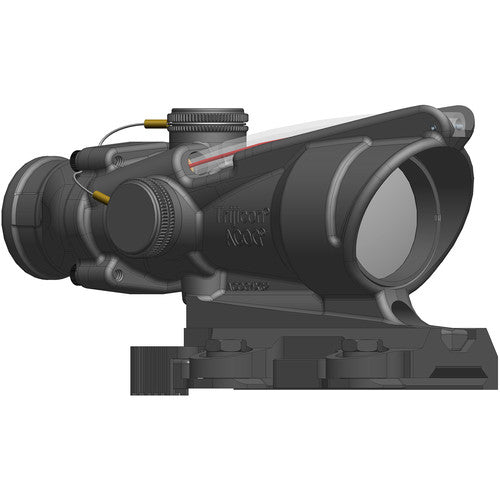

Trijicon ACOG 4x32 BAC Dual-Illum Rifle Combat Optic offers a 4x magnification and a 32mm objective lens that ensures a clear and precise image for tactical applications. Its dual illumination technology combines fiber optics and tritium, providing a reticle that's visible in various lighting conditions. This feature enhances your ability to quickly acquire targets while maintaining situational awareness in any environment. The optic’s red horseshoe dot reticle facilitates rapid target engagement at close ranges and accuracy at longer distances, with a Bullet Drop Compensator (BDC) calibrated for 5.56/.223 ammunition.
Built to withstand harsh conditions, the rugged forged aluminum housing guarantees durability and reliability. With a fixed parallax adjustment and a field of view of 36.8 feet at 100 yards, it offers a broad sight picture for enhanced visibility. The Trijicon ACOG 4x32 BAC is waterproof up to 11 meters and operates without batteries, making it a dependable choice for military personnel, law enforcement, and serious shooters.
Key Features:
- DUAL ILLUMINATION: Provides a reticle that remains visible in all lighting conditions without needing batteries.
- RED HORSESHOE DOT RETICLE: Enables quick target acquisition and precise shooting at various distances.
- BULLET DROP COMPENSATOR: Calibrated for 5.56/.223 ammunition for accurate shooting at extended ranges.
- RUGGED CONSTRUCTION: Made from forged aluminum to ensure durability in demanding environments.
- WIDE FIELD OF VIEW: Delivers 36.8 feet at 100 yards for an expansive and clear sight picture.
- FIXED PARALLAX: Simplifies the aiming process by eliminating the need for adjustments.
- WATERPROOF: Functional under water up to 11 meters, suitable for wet conditions.
- NO BATTERIES REQUIRED: Dual illumination system ensures readiness without the need for external power sources.
Technical Specifications
| Specification | Details |
|---|---|
| Item Condition | New |
| Scope Weight | 14.2 oz. |
| Scope Length | 6" |
| Magnification Range | 4x |
| Scope Objective Diameter | 32mm |
| Turret Adjustment (Click Value) | 2 clicks/inch @ 100 yards |
| Parallax Adjustment | Fixed |
| Reticle Details | Red Horseshoe Dot Reticle |
| Field of View | 7° / 36.8 ft @ 100 yards |
| Exit Pupil | 8.1 mm |
| Eye Relief | 1.5" |
| Illuminated Reticle | No |
| Scope Finish | Black |
| Product Type | Riflescopes |
| UPC | 719307312142 |
| MPN | 100582 |
What's in the Box?
- LaRue Tactical Mount
- Assemblies for 1/10 Miliradian External Adjusters
- External Adjuster Caps
- Lanyard Assembly for Adjuster Caps
- Scopecoat
- LensPen
- RCO Manual
- Warranty Card
Customer Reviews
"This optic has been a game-changer for my shooting accuracy. The reticle is always clear, no matter the light." - Jake R.
"Sturdy and reliable, the ACOG is the best investment I've made for my tactical gear." - Sarah L.
"I love how easy it is to target with this scope. It works perfectly in all conditions." - Mike T.
FAQ
How does the dual illumination work in varying light conditions? The Trijicon ACOG features both fiber optics and tritium, ensuring the reticle remains visible in bright sunlight or complete darkness. This dual system provides flexibility for all environments.
Is maintenance required for the ACOG? Regular cleaning of the lenses with a LensPen or similar tool is recommended to maintain clarity. Due to its rugged construction, the ACOG requires minimal maintenance, making it user-friendly for tactical applications.
How does this compare to other tactical optics? The ACOG stands out due to its dual illumination system and robust design. Unlike battery-operated optics, the ACOG is always ready for use, providing reliability in critical situations. However, if you prefer variable magnification, consider other models that offer that feature.
Similar Models
Looking for more tactical optics? Explore our complete Trijicon lineup, including models like the Trijicon VCOG 1-6x24 for versatile magnification and the Trijicon RMR Type 2 for enhanced reflex shooting. Discover the full collection for the best in optics designed for performance and reliability.
You May Also Like
Here’s some of our most similar products people are buying. Click to discover trending style.










